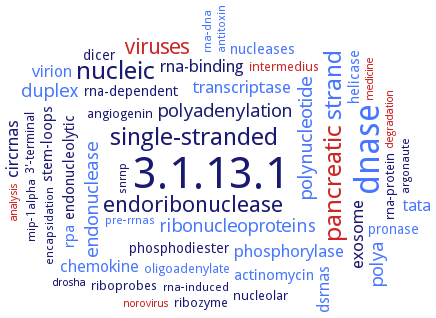3.1.13.1: exoribonuclease II
This is an abbreviated version!
For detailed information about exoribonuclease II, go to the full flat file.

Word Map on EC 3.1.13.1 
-
3.1.13.1
-
dnase
-
nucleic
-
pancreatic
-
strand
-
single-stranded
-
endoribonuclease
-
viruses
-
polynucleotide
-
endonuclease
-
polyadenylation
-
duplex
-
polya
-
ribonucleoproteins
-
transcriptase
-
rna-binding
-
circrnas
-
exosome
-
phosphorylase
-
chemokine
-
dsrnas
-
tata
-
virion
-
rpa
-
nucleases
-
stem-loops
-
actinomycin
-
helicase
-
endonucleolytic
-
dicer
-
phosphodiester
-
rna-dependent
-
pronase
-
intermedius
-
oligoadenylate
-
riboprobes
-
rna-protein
-
nucleolar
-
ribozyme
-
3'-terminal
-
angiogenin
-
argonaute
-
encapsidation
-
rna-induced
-
pre-rrnas
-
rna-dna
-
antitoxin
-
mip-1alpha
-
snrnp
-
medicine
-
drosha
-
degradation
-
analysis
-
norovirus
- 3.1.13.1
- dnase
- nucleic
- pancreatic
- strand
-
single-stranded
-
endoribonuclease
- viruses
- polynucleotide
- endonuclease
-
polyadenylation
- duplex
- polya
- ribonucleoproteins
- transcriptase
-
rna-binding
-
circrnas
-
exosome
- phosphorylase
- chemokine
- dsrnas
- tata
- virion
- rpa
- nucleases
-
stem-loops
- actinomycin
- helicase
-
endonucleolytic
- dicer
-
phosphodiester
-
rna-dependent
- pronase
- intermedius
- oligoadenylate
-
riboprobes
-
rna-protein
-
nucleolar
-
ribozyme
-
3'-terminal
-
angiogenin
-
argonaute
-
encapsidation
-
rna-induced
- pre-rrnas
- rna-dna
- antitoxin
-
mip-1alpha
-
snrnp
- medicine
- drosha
- degradation
- analysis
- norovirus
Reaction
Exonucleolytic cleavage in the 3'- to 5'- direction to yield nucleoside 5'-phosphates =
Synonyms
3'-5'exoribonuclease, 3�-5�exoribonuclease, 5'->3' exoribonuclease 2, AB205_0003320, Dis, Dis3, EC 3.1.4.20, exonuclease ISG20, More, PfRNase II, RC-RNase 2, ribonuclease 2, ribonuclease II, ribonuclease Q, Ribonuclease R, RNase, RNase 2, RNase A, RNase II, RNase R, RNase-2, RNaseR, Rnb, RNR, RNR1, Rrp44, XRN2
ECTree
Advanced search results
Cloned
Cloned on EC 3.1.13.1 - exoribonuclease II
Please wait a moment until all data is loaded. This message will disappear when all data is loaded.
DNA fragments corresponding to the entire open reading frame in each gene are subcloned into a TA cloning vector
-
expressed in Escherichia coli as a glutathione-S-transferasa fusion protein
-
Expression of rnr mutant (inactivation of Rnase R) is performed in Escherichia coli. Overexpression of genes corresponding to the flagellar apparatus or to the biosynthesis of cofactors by the absence of RNase R gene.
full-length Rrp44 (residues 1-1001) and truncated constructs of Rrp44 expressed from a pETM11 vector in Escherichia coli
into the pET-15b vector, cloned into Escherichia coli DH5alpha, subsequently transformed into Escherichia coli strain BL21(DE3)
-
into the pET-15b vector, transformed into Escherichia coli Novablue, subsequently transformed into Escherichia coli strain BL21(DE3)
pACYC184 derivative expressing RNase II, RNase II lacking cold shock domain-1 or mutant D209N under araBAD promoter. PACYC184 derivative expressing RNase R under araBAD promoter. RNase II and mutant D209N overexpressed from pET plasmid constructs in CH12 DELTArna cells
-
recombinant expression of His6-tagged wild-type and mutant enzymes in Escherichia coli strain BL21(DE3), enzyme expression for complementation in Escherichia coli MG1693-derivative strain CMA401
recombinant expression of RC-RNase 2 with an extra Met at its N-terminus in Escherichia coli strain BL21(DE3) in inclusion bodies
recombinant overexpression of His-tagged wild-type non-acetylated and acetylated RNase II and of FLAG-tagged wild-type and mutant enzymes in Escherichia coli strain BL21(DE3) lacking Pka or CobB
RNase II wild-type, mutant and truncated proteins, cloned into plasmid pFCT6.1, overexpressed in Escherichia coli BL21(DE3)
-
RNase R and RNase II constructs cloned into vector pET44R and overexpressed in Escherichia coli BL21II-R-(DE3)pLysS
-
vapour-diffusion method, wild-type RNase II is crystallized in two crystal forms, both of which belonged to space group P2(1). X-ray diffraction data are collected to 2.44 and 2.75 A resolution, with unit-cell parameters a = 56.8, b = 125.7, c = 66.2 A, beta = 111.9° and a = 119.6, b = 57.2, c = 121.2 A, beta = 99.7°, respectively. The RNase II D209N mutant gives crystals that belonged to space group P6(5), with unit-cell parameters a = b = 86.3, c = 279.2 A, and diffract to 2.74 A
wild-type and mutants overexpressed from pFCT6.9 vector as His6-tagged fusion proteins in Escherichia coli BL21(DE3)
wild-type and RNase II mutants cloned into plasmid pFCT6.9 and expressed in Escherichia coli BL21(DE3)
wild-type Rrp44, Rrp44-20, and Rrp44-cat are expressed in Escherichia coli as GST fusions
X-ray crystallographic structures of both the ligand-free (at 2.44 A resolution) and RNA-bound (at 2.74 A resolution) forms of RNase II. Structures show that RNase II is organized into four domains: two cold-shock domains, one RNB catalytic domain, which has an unprecedented alphabeta-fold, and one S1 domain. The active site is buried within the RNB catalytic domain, in a pocket formed by four conserved sequence motifs. The structure shows that the catalytic pocket is only accessible to single-stranded RNA, and explains the specificity for RNA versus DNA cleavage. It also explains the dynamic mechanism of RNA degradation by providing the structural basis for RNA translocation and enzyme processivity


 results (
results ( results (
results ( top
top





